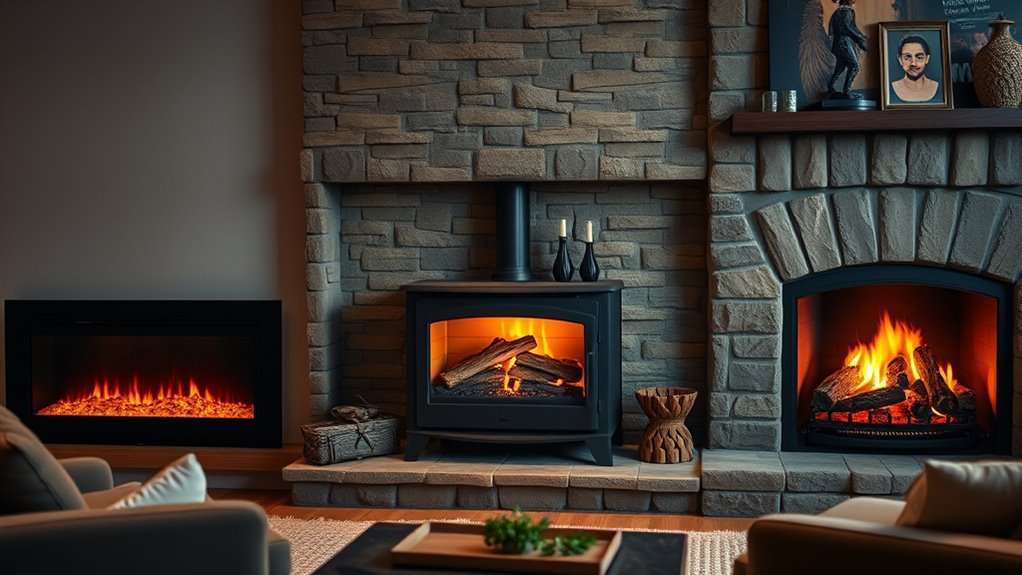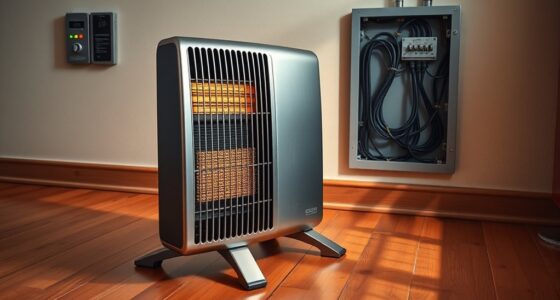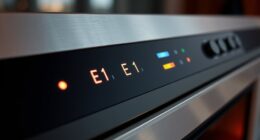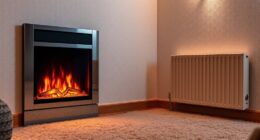If you’re choosing between electric, gas, and wood fireplaces, consider your priorities. Electric models are easy to install, energy-efficient, and require minimal maintenance, but lack the traditional charm. Gas fireplaces offer convenience, cleaner operation, and good heat output but need venting and regular inspections. Wood fires provide authentic ambiance and lower initial costs but demand more effort for upkeep and cleaning. Keep exploring to find out which option best suits your home and lifestyle.
Key Takeaways
- Electric fireplaces are highly energy-efficient, easy to install, and require minimal maintenance.
- Gas fireplaces offer quick, clean heat with moderate installation costs but need venting and regular inspections.
- Wood fireplaces provide traditional ambiance but have lower efficiency, higher upkeep, and require chimney cleaning.
- Electric models produce no smoke, soot, or emissions, enhancing indoor air quality and safety.
- Gas and wood fireplaces often involve higher installation and ongoing costs compared to electric options.
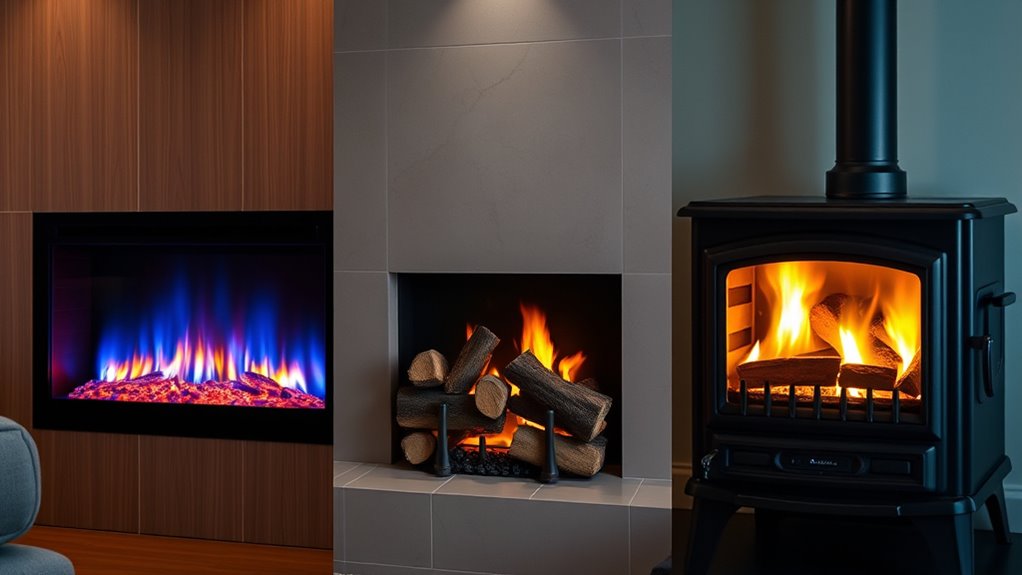
Choosing the right fireplace depends on your needs and preferences, as each type offers distinct advantages and drawbacks. When evaluating electric, gas, and wood fireplaces, one of the key considerations is energy efficiency. Electric fireplaces are generally the most energy-efficient because they convert nearly all the electricity into heat, with minimal waste. They also don’t require venting, so you save on installation costs and avoid complex chimney work. Gas fireplaces tend to be less efficient than electric models but still offer good energy use, especially modern units designed to maximize heat output while minimizing waste. Wood fireplaces, on the other hand, are typically less energy-efficient because much of the heat escapes up the chimney, and they often require a lot of wood to produce a substantial amount of warmth.
Installation costs vary considerably among these options. Electric fireplaces are usually the cheapest to install since they simply plug into a standard outlet and don’t need venting or chimney work. Gas fireplaces require professional installation to connect to your gas line and ensure proper venting, which can increase costs considerably. The expense depends on whether you’re converting an existing wood fireplace or installing a new gas unit, but it generally involves a higher upfront investment. Wood fireplaces are often the most inexpensive to set up initially; however, you need to factor in the ongoing costs of purchasing or chopping wood, as well as the maintenance involved in cleaning the chimney and flues.
Another aspect to contemplate is the convenience and safety features. Electric fireplaces are incredibly user-friendly—they turn on and off with a switch or remote, and they don’t produce smoke, soot, or carbon monoxide. Gas fireplaces offer a similar level of ease but require proper venting and regular inspections to prevent leaks or buildup. Wood fireplaces, while traditional, demand more effort: you need to gather, store, and regularly tend the fire, and they produce smoke and ash that require cleanup. Safety is also a concern; electric and gas options tend to be cleaner and safer in terms of indoor air quality, whereas wood fireplaces pose risks of creosote buildup and chimney fires if not maintained properly.
Additionally, modern projector technology can enhance your viewing experience if you are considering a multi-purpose entertainment space alongside your fireplace.
Frequently Asked Questions
Which Fireplace Type Is Safest for Households With Children or Pets?
You should consider electric fireplaces, as they are the safest for households with children or pets. Electric models don’t produce real flames, so there’s no risk of burns or accidental fires. They also lack harmful emissions, making them safer for pet safety and child safety. Plus, they often come with features like automatic shut-off, giving you added peace of mind. Overall, electric fireplaces provide a safer environment for your family and furry friends.
How Do Maintenance Costs Compare Among Electric, Gas, and Wood Fireplaces?
You might think electric fireplaces are cheapest to maintain, but gas and wood options can be more costly long-term. Electric fireplaces generally have lower installation costs and minimal upkeep, while gas fireplaces require regular inspections, and wood fireplaces need chimneys cleaned annually. Over time, expenses for gas and wood fireplaces add up with maintenance and repairs, unlike electric units that mainly need occasional cleaning. Your choice depends on balancing initial costs with ongoing expenses.
Can Electric Fireplaces Effectively Heat Large Rooms or Outdoor Spaces?
Electric fireplaces can be effective for heating large rooms or outdoor spaces, especially if they have high energy efficiency ratings. However, their ability to heat extensive areas depends on the model and wattage. You’ll find they’re easy to install since they require minimal setup, making them a convenient choice. Keep in mind, though, that for very large spaces, electric fireplaces might struggle compared to gas or wood options.
Are There Environmental Regulations Affecting the Use of Gas or Wood Fireplaces?
You might worry about environmental regulations, but yes, air quality regulations and emissions standards do influence gas and wood fireplaces. Some areas restrict wood burning during poor air quality days, and gas fireplaces must meet strict emissions standards. These rules aim to reduce pollution and improve air quality. So, check local regulations before installing or using your fireplace to ensure you’re compliant and contributing to cleaner air.
What Are the Best Options for Remote or Smart Control Integration?
You should look for fireplaces with smart home compatibility that support remote control options. Many electric and gas fireplaces now come with Wi-Fi or Bluetooth connectivity, allowing you to control temperature, flame effects, and on/off functions via smartphone apps or voice commands. Wood fireplaces generally lack these features, but some modern models include optional remote controls for convenience. Prioritize options that seamlessly integrate with your existing smart home system for the best experience.
Conclusion
Choosing between electric, gas, or wood fireplaces is like picking the perfect paintbrush for your art—each has its unique charm. Electric offers convenience, gas provides clean warmth, and wood delivers cozy tradition. Weigh their pros and cons to find what truly warms your heart. Remember, the right fireplace is the canvas where your comfort and style blend seamlessly, turning your space into a warm, inviting masterpiece you’ll love coming home to.
